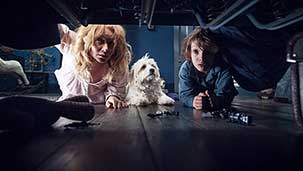The best genre films are never by-the-numbers. They employ the comfort of convention as a way to explore deeper issues. Sci-fi, for example, is always richer as allegory. The most piercing comedy is often the simple result of tragedy plus time. Yet horror films are too often satisfied with immediate, visceral thrills—the kind of generic cinematic experience a “casual” director might be satisfied delivering.
The Babadook proves that Jennifer Kent is no casual director.
Funny, then, that she hired two “casual” ADs for this film. That word, both in North America and Australia (where The Babadook was shot) can of course have multiple meanings. Perhaps you were only there on a part-time basis. After all, the film doesn’t feature any big international stars and was made for a modest 2 million. But “casual” also has more negative connotations: from unplanned, to superficial, to indifferent. None of which apply to the filmmaking I witnessed.
The Babadook is a careful and considered entry into the crowded supernatural thriller genre. It can “casually” be described like a thousand other films: a mother tries to convince her child that the monster he is seeing in their house isn’t real—until, of course, the sinister force becomes too powerful to deny. As an entry point, that might be all the audience needs. But I hope you, at least, realized that the premise is actually an excellent way to explore PTSD, grappling with grief, and the pressures of being a single parent. None of that sounds too sexy for the poster, but in the same way the Babadook monster is explained through a hand-made pop-up kids book, the very menacing truth behind the message is what makes the film so haunting.
You also must have taken note, even in your cursory position, that Kent had structured her screenplay like an exorcism film, but made it secularized, and, ultimately, internalized. This evil-within-us approach is much more chilling, and brilliantly reinforced by one of those inexplicable news reports about a mother’s murder-suicide with her children. That simple injection of a familiar real-world horror story makes the fear very personal and much less outlandish that it could have been. In fact, the slow-burn of the film’s first act, devoid of any scares (earned or cheated), establishes believable characters in a recognizable world, all of which enhances the more fantastical events of the the following acts.
The two central performances by Essie Davis and the seven-year-old Noah Wiseman are easily the most memorable aspects of the film. But they’re also serviced by the perfectly atmospheric low-light cinematography, the rigorous art direction (with a strict adherence to moody colour palettes), and the subdued sound design that never once gives us cat-jumping false alarm jitters.
So maybe your position makes sense. I can see how, after making a short film based on the same story almost a decade ago, Jennifer Kent might hire a couple young aspiring directors for her first feature film, sit back, and casually say: “Don’t worry. I got this shit.”
Sincerely,

Christopher







